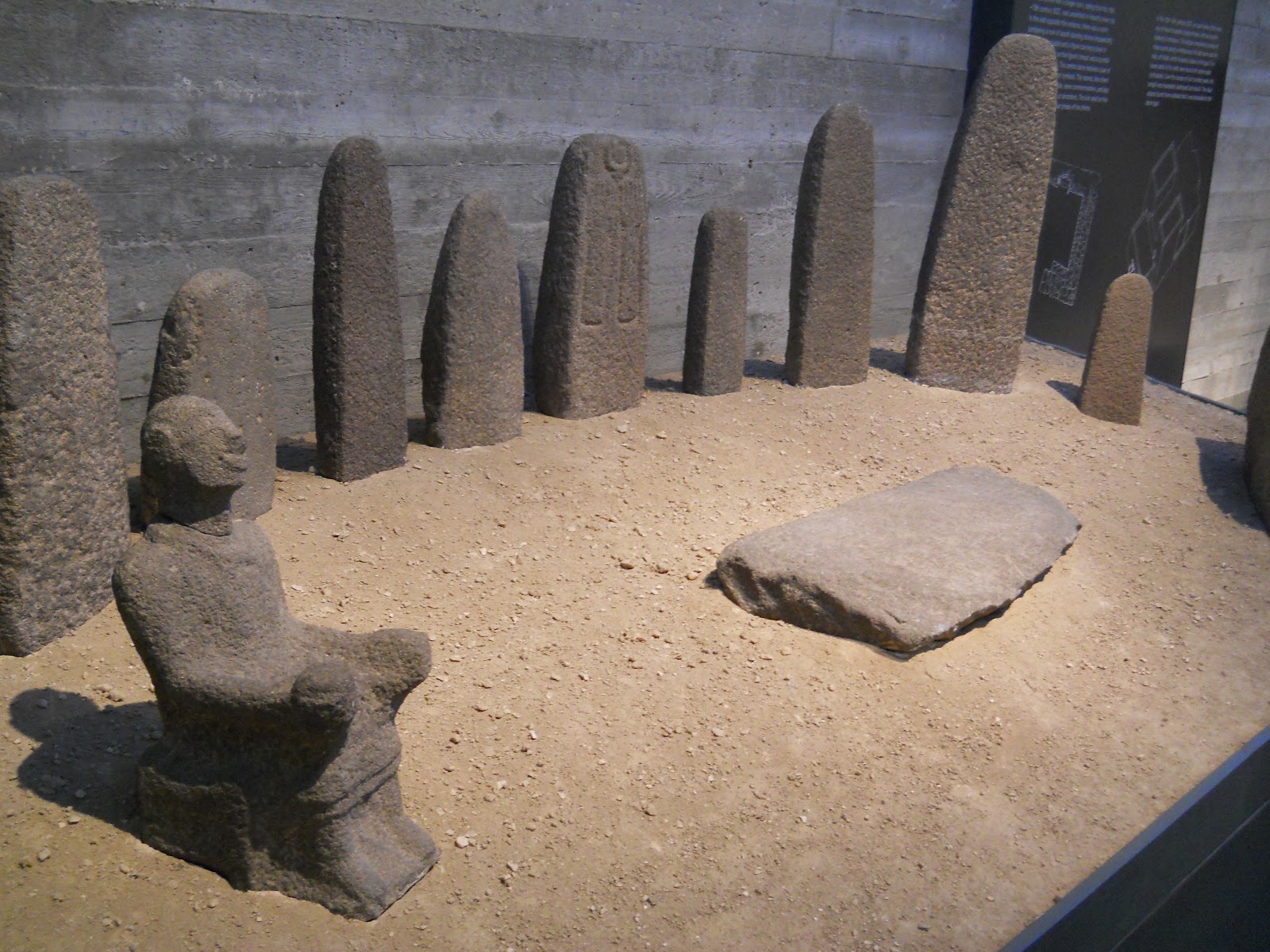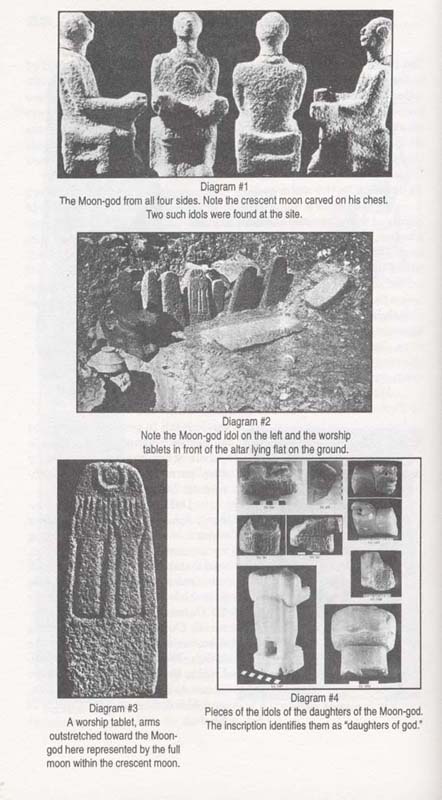𝐓𝐡𝐞 𝐌𝐲𝐬𝐭𝐞𝐫𝐢𝐨𝐮𝐬 𝐇𝐚𝐳𝐨𝐫 𝐒𝐭𝐚𝐭𝐮𝐞: 𝐓𝐡𝐞 “𝐀𝐥𝐥𝐚𝐡” 𝐎𝐟 𝐓𝐡𝐞 𝐌𝐮𝐬𝐥𝐢𝐦𝐬?
Mohamad Mostafa Nassar
Twitter:@NassarMohamadMR
For years the Christian missionaries have been entertaining the idea that “Allah” of the Qur’an was in fact a pagan Arab “moon god” of pre-Islamic times. This theory was first popularised by a fanatical, mid-Western closet-fascist polemicist by the name of Dr. Robert Morey, of whose deceptive methods have already been exposed in the past. The following page is found in “Appendix C: The Moon God And Archaeology” from Morey’s The Islamic Invasion and lies at the heart of the missionary propaganda today.

“He it is who cleaves out the morning, and makes the night a repose, and the sun and the moon two reckonings (of Time). That is the decree of the Mighty, the Wise.” [Qur’an 6:97]
For years the Christian missionaries have been entertaining the idea that “Allah” of the Qur’an was, in fact, Allah the moon god of the Kaaba and a pagan Arab “moon god” of pre-Islamic times. This theory was first popularised by a fanatical, mid-Western closet-fascist polemicist by the name of Dr Robert Morey, of which his deceptive methods have already been exposed in the past.
The following page is found in “Appendix C: The Moon God And Archaelogy” from Morey’s The Islamic Invasion and lies at the heart of the missionary propaganda today1:
Naturally, the missionaries get very excited at the idea of anything that has the “potential” of demeaning Islam and lifted (or should we say, plagiarised) this claim of Morey. This “theory” later became widespread and gained notoriety among gullible Christians, so much so that Jack T. Chick, another Christian polemicist, drew a fictionalised racist cartoon story entitled “Allah Has No Son”. More examples of this opportunistic propaganda being repeated at various missionary websites all over the WWW could also be found.
We have previously discussed the word “Allah” from an etymological perspective, as well as having shown how the word “Allah” is consistently translated as “Elohim” in a Hebrew translation of the Qur’an. It is obvious that these “pseudo-scholars” have no idea about what they are dealing with, much less understand the subject matter.
Therefore, our intention here to expose the ignorance these missionaries have about one of the best-known objects from Israel/Palestine and is now currently on exhibition in the Israel Museum, Jerusalem., Reply to Robert Morey’s Moon-God Allah Myth: A Look At The Archaeological Evidence, of which this author is one of the co-writers.
The Shrine At Hazor (Area C)
It is known among Near Eastern archeological circles that the statue which the missionaries claim to be the “moon-god Allah” (as parroted from Robert Morey) comes from the ruins of Hazor (Area C), a very prominent bronze-age city in Galilee (in present-day Israel/Occupied Palestinian Territories) and belongs to a shrine, 4.75 x 3.4 m in size, furnished with an offering table, a lion orthostat, the statue in question, and ten stelae, all made from regional black basalt.2
The shrine is described as follows:
At Hazor, a small shrine in Area C of the Lower City probably served families residing nearby. It comprised a single broad room and was built on the inner slope of the Middle Bronze Age rampart. A row of eleven stelae was erected in this room-the central one of which was carved in relief, depicting two hands in prayer posture below a moon-and-crescent symbol. The shrine included also a miniature relief of a crouching lion, a statue of a sitting male figure (possibly depicting a god or a priest) and an offering table made of one stone slab.3
The central stelae show a pair of hands raised (stipulated to be in adoration) below a crescent plus circle symbol, usually considered to depict the crescent moon plus the full moon. The other stelae are plain. Therefore the whole shrine has been interpreted as referring to the moon cult.
Description of The Hazor Statue
It is without a shadow of a doubt that Robert Morey has attempted to present the Hazor statue as “the moon god”. Note the following description of Diagram #1 by Morey:
Now let us focus on discussing the object itself4, which is currently being fawned upon by the rabid Christian missionaries and paraded by them as the “moon god idol, Allah.
The statue — 40 cm in height — depicts a male person with an inverted crescent suspended from his necklace and holding a cup in his right hand, certainly as an offering.
The statue was found decapitated, and the head was discovered lying on a floor at a lower level. It depicts a man, possibly a priest, seated on a cubelike stool. He is beardless with a shaven head; his skirt ends below his knees in an accentuated hem; his feet are bare. He holds a cup in his right hand, while his left, clenched into a fist, rests on his left knee. An inverted crescent is suspended from his necklace.5
Pictures and descriptions of the shrine and the statue may be found in virtually every comprehensive publication on the archaeology of Israel/Palestine.6
Is this statue, therefore, the “Allah” of the Muslims? The answer is an obvious no. The statue is not even an “idol” at all — it does not represent any deity, but a human worshipper or priest of a deity which may well have been a Canaanite moon god7. The statue is also described in a caption as a “Basalt statue of deity or king from the stelae temple”.8
But one is compelled to ask, was the decapitation of the head of the statue intentional or otherwise and if so, what was its significance?
This was addressed by Beth Alpert Nakhai as follows:
A decapitated basalt statue of a seated man, his head lying nearby, was also found in the niche. This statue resembled the decapitated statue from the Orthostat Temple and again the intentional beheading is considered indicative of the individual’s special status….9
It should be noted that there are indeed dissenting opinions among scholars as to the nature of the statue, of which the more popular opinions are (a) a god, (b) a king, or (c) a priest.10
But to the scholars who reject opinion (a), it seems illogical that a god should hold offering vessels in his hand(s); the god is usually the one who receives offerings, therefore the statue should, in all probability depict a worshipper to a god, who himself is in a way considered present, either invisibly or in the upright stones (stelae) of the sanctuary.
Further, how could a god’s statue be arranged anywhere but in the centre of the sanctuary? The statue in question is seated at the left fringes of the shrine, which can hardly be the proper position for a revered god.
Regardless of the differing opinions, however, certainly no serious scholar — including those who considered the possibility that it could be a god — has ever identified the statue with Allah.
Conclusions
It is clear that, contrary to what Robert Morey or the Christian missionaries would like to themselves admit, the figure presented as the “moon-god” is not even remotely connected to Islam, much less related to the pantheon of the pre-Islamic Arab deities in the city of Makkah and their claim is swiftly refuted by solid, overwhelming archaeological evidence.
Moreover, this figure was found in the ancient ruins of Hazor (located in present-day Israel) and is not necessarily believed to have even represented a deity.
In commenting on the issue, the Bible scholar and missionary Rick Brown admit that:
It is sometimes claimed that there is a temple to the moon god at Hazor in Palestine. This is based on a representation thereof a supplicant wearing a crescent-like pendant. It is not clear, however, that the pendant symbolizes a moon god, and in any case this is not an Arab religious site but an ancient Canaanite site, which was destroyed by Joshua in about 1250 BC.11
Thus, the contents of the Morey’s inconsequential polemic of the so-called “cult” of the moon-god, most especially the “Allah Hazor statue” polemic, have got nothing to do with serious ancient Near Eastern scholarship and should, therefore, be utterly dismissed outright by any objective person. Its obvious intention is clearly to defame Muslims and the religion of Islam — and nothing else.
We would also like to add that the findings in this paper has also been incorporated ‘ latest publication, Reply to Robert Morey’s Moon-God Allah Myth: A Look At The Archaeological Evidence, of which this author is one of the co-writers.
The paper also looks at various aspects of the propagation of the moon-god myth not covered in the scope of this article, therefore we would implore interested readers to have a look at the paper by Islamic Awareness in order to understand how the argument that “Allah is the moon-god” is, at best, fallacious.
And only Allah knows best!
Acknowledgments
The author would like to thank Dr. Stefan J. Wimmer from the University of Munich and the Friends of Abraham Society for the help offered in obtaining information and the relevant material on the statue of Hazor. Dr. Wimmer is not associated with Islam Compass .Cite this article as: Islam Compass Team, “The Mysterious Hazor Statue: The “Allah” Of The Muslims?,”
- Robert Morey, The Islamic Invasion: Confronting The World’s Fastest-Growing Religion (Harvest House Publishers, 1992), p. 214 []
- Yigael Yadin, Hazor (Hoffman und Campe, Hamburg, 1976), pp. 44-45 []
- Amihai Mazar, Archaeology of the Land of the Bible (Doubleday, 1990), pp. 253-54 []
- Yigael Yadin, op. cit. []
- Treasures of The Holy Land: Ancient Art From The Israel Museum (Metropolitan Museum of Art, NY:1986), p. 107 []
- See for example Amnon Ben-Tor (ed.), The Archaeology of Ancient Israel (New Haven, London, 1992) and Ephraim Stern (ed.), The New Encyclopedia of Archeological Excavations in the Holy Land, Vol 2 (The Israel Exploration Society, Carta, Jerusalem), cf. the rest of the cited scholarly works in this article (with the exception of Morey’s polemical work). []
- For the worship of the moon in the Canaanite realm the most recent comprehensive treatment is Gabriele Theuer, Der Mondgott in den Religionen Syrien-Palaestinas, OBO 173, Fribourg (Switzerland), 2000 (in German). []
- Michael Avi-Yonah (ed., English), Encyclopedia of Archeological Excavations in the Holy Land, Vol. II (The Israel Exploration Society and Massada Press, Jerusalem, 1976), p. 476 []
- Beth Alpert Nakhai, Archaelogy and the Religions of Canaan and Israel, (American Schools of Oriental Research, 2001), p. 130 []
- Yigael Yadin in Hazor (Hoffman und Campe, Hamburg, 1976) proposed all three opinions, of which he argues in favour of the first opinion, i.e. that the statue is a deity. However, he certainly neither makes mention of nor does he connect the statue to Allah. []
- Rick Brown, Who Is “Allah”?, International Journal of Frontier Missions 23:2 (Summer 2006), p. 79 []